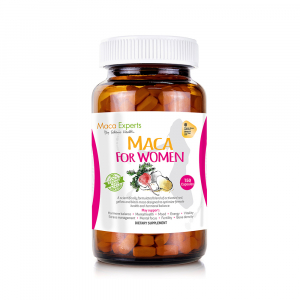How to improve fertility in men and women with maca
Figure 1. Maca treatment plan for couples trying to conceive. Women take daily maca for women and additional extracted red maca (pink and red), men take daily maca for men and additional extracted black maca (grey and black).
For women
Step 1:
Take 1-1.5 tsp of powder or 3-5 cpsules per day of Maca for Women with breakfast or lunch (Figure 1). Minimum suggested treatment time is 6-12 weeks. Beyond this you may continue to consume maca daily and do not require taking a break from treatment if you are receiving positive benefits. For recipe ideas of how to include maca in your daily routine download our recipe booklet here or watch our recipe channel here.
1-1.5 tsp per day
3-5 capsules per day
Step 2:
Take 1-2 tsp per day of Concentrated Red Maca in addition with breakfast, lunch or dinner during the luteal phase of your cycle when experiencing PMS symptoms. Continue until PMS symptoms cease or menstruation occurs (approx. 6-15 tsp per month – Figure 1). Dissolve the powder into water, a tea, juice, smoothie or other drink. Minimum suggested treatment time is 6-12 weeks. If symptoms improve then you may either continue on with treatment or reduce to just daily Maca for Women.
1-2 tsp per day for PMS symptoms
For men
Step 1:
Take 1-1.5 tsp of powder or 3-5 capsules per day of Maca for Men with breakfast or lunch (Figure 1). Minimum suggested treatment time is 6-12 weeks. Beyond this you may continue to consume maca daily and do not require taking a break from treatment if you are receiving positive benefits. For recipe ideas of how to include maca in your daily routine download our recipe booklet here or watch our recipe channel here.
1-1.5 tsp per day
3-5 capsules per day
Step 2:
Take 1-2 tsp per day of Concentrated Black Maca in addition with breakfast, lunch or dinner during the follicular phase of your partners cycle to build sperm count, function, libido and sexual performance. Continue until ovulation (approx. 10-12 tsp per month – Figure 1). Dissolve the powder into water, a tea, juice, smoothie or other drink. Minimum suggested treatment time is 6-12 weeks.
1-2 tsp per day during follicular phase
Treating fertility in women and men
The typical menstrual cycle lasts for 28 days (Figure 2) with fertility occurring after ovarian follicle development releases an oocyte, and the uterine endometrium layer changes to support the implantation of a fertilised egg (Ovulatory Phase).1 Natural family planning methods provide a physiological means to detect the fertile window of a woman’s reproductive cycle. Practices commonly used are basal body temperature charting, calendar calculation, cervical mucus monitoring, lactational amenorrhea, and the symptothermal method.2 Essentially, the female reproductive cycle is controlled by the hypothalamic pituitary axis (HPA), which releases gonadotrophin-releasing hormone (GnRH), thereby stimulating luteinising hormone (LH) and follicle stimulating hormone (FSH) secretion from the pituitary gland. In response to a spike in LH (Ovulatory Phase), enzymes break down the follicle to release the now mature ovum, and progesterone levels continue to increase (Figure 2). Daily tests for LH produce reliable predictions of the beginning of ovulation.3 Women with conditions such as endometriosis and polycystic ovarian syndrome (PCOS) have a high risk of infertility due to imbalances of hormonal cycles4,5. For men, low sperm concentration, poor sperm motility, and abnormal sperm morphology are all sub-fertility and infertility risk factors that reduce the chances of conception.6 Infertility affects up to 10% of women in reproductive age and is a public health issue according to the World Health Organization (WHO).7
Figure 2. Female hormonal cycles.
Amongst the many means of addressing infertility, those wishing to conceive may benefit from taking maca, an Andean root used for centuries to support fertility. In Peru young adolescent women are given maca daily as a tea when they reach puberty to harmonise their menstrual cycles and reduce the symptoms of PMS. As adults women take combinations of red and yellow maca in-line with their periods to improve fertility and maintain hormonal harmony. Men also traditionally take yellow and black maca to improve their fertility and enhance their libido and sexual function.
How Maca can assist with fertility in men and women
In a laboratory study, dietary consumption of maca increased the probability of embryo implantation in mice8, which may be due to increasing the natural pre-ovulation luteinizing hormone surge9. Another benefit to women is that maca alleviates psychological stress10 and was proposed as a treatment for antidepressant-induced sexual dysfunction11. Recently, it has been demonstrated that atomised (extracted) red maca is the most effective form of maca to improve quality of embryos in mice.12 Maca also benefits hormonal balance in women during the regular menstrual cycle and menopause.
In men, one study analysed sperm concentration, sperm motility, and sperm morphology of those whose partners had pregnancies within 12 cycles compared to those who did not. Men with partner pregnancies showed consistently higher volume, concentration, number and percentage motile and morphologically normal, and total sperm6. Interestingly, dietary patterns, foods, and nutrients have been observed to impact male fertility, as measured with several sperm quality parameters13. With long-term administration of yellow maca, stallions’ concentration of spermatozoa and total sperm count increased during 60-120 days after dietary supplementation14. In addition, acute administration of black maca increases the concentration of sperm count in epididymis and vas deferens15. Read more on treating sexual function and libido in men. For those struggling to conceive or just wanting to increase their chances of conception and produce healthier babies, maca is a 100% natural supplement with good clinical evidence to support it’s use.
Note: There is no upper limit with maca and everybody is different, so it is important to find your ideal dose that is right for your body, for some this may be less than the recommended for others it may be more. If you experience positive health benefits then we suggest you continue treatment at that ideal dosage. The material provided on this website is for information purposes only. It is not intended to replace medical advice or be a treatment for any medical condition. Users should consult a health professional if you have any concerns about your health, are starting any health or nutritional related treatment, or for any questions you may have regarding your own or any other party’s medical condition. Information and statements regarding dietary supplements have not been evaluated by the Food and Drug Administration and are not intended to diagnose, treat, cure, or prevent any disease.
Bibliography
1. Taylor, A. E., Whitney, H., Hall, J. E., Martin, Kathryn., & Crowley Jr, W. F. (1995). Midcycle levels of sex steroids are sufficient to recreate the follicle-stimulating hormone but not the luteinizing hormone midcycle surge: evidence for the contribution of other ovarian factors to the surge in normal women. The Journal of Clinical Endocrinology & Metabolism, 80(5), 1541-1547. https://www.ncbi.nlm.nih.gov/pubmed/7744998
2. Smoley, B. A., & Robinson, C. M. (2012). Natural family planning. American family physician, 86(10). https://www.ncbi.nlm.nih.gov/pubmed/23157145
3. Brown, J. B. (2010). Types of ovarian activity in women and their significance: the continuum (a reinterpretation of early findings). Human Reproduction Update, 17(2), 141-158. https://www.ncbi.nlm.nih.gov/pubmed/20923873
4. Greene, A. D., Lang, S. A., Kendziorski, J. A., Sroga-Rios, J. M., Herzog, T. J., & Burns, K. A. (2016). Endometriosis: where are we and where are we going?. Reproduction (Cambridge, England), 152(3), R63–R78. doi:10.1530/REP-16-0052. https://www.ncbi.nlm.nih.gov/pmc/articles/PMC4958554/
5. El Hayek, S., Bitar, L., Hamdar, L. H., Mirza, F. G., & Daoud, G. (2016). Poly Cystic Ovarian Syndrome: An Updated Overview. Frontiers in physiology, 7, 124. doi:10.3389/fphys.2016.00124. https://www.ncbi.nlm.nih.gov/pubmed/27092084
6. Zinaman, M. J., Brown, C. C., Selevan, S. G., & Clegg, E. D. (2000). Semen quality and human fertility: a prospective study with healthy couples. Journal of Andrology, 21(1), 145-153. https://www.ncbi.nlm.nih.gov/pubmed/10670528
7. Infertility is a global public health issue. (n.d.). Retrieved July 26, 2019, from https://www.who.int/reproductivehealth/topics/infertility/perspective/en/
8. Ruiz-Luna, A. C., Salazar, S., Aspajo, N. J., Rubio, J., Gasco, M., & Gonzales, G. F. (2005). Lepidium meyenii (Maca) increases litter size in normal adult female mice. Reproductive Biology and Endocrinology, 3(1), 16. https://www.ncbi.nlm.nih.gov/pubmed/15869705
9. Uchiyama, F., Jikyo, T., Takeda, R., & Ogata, M. (2014). Lepidium meyenii (Maca) enhances the serum levels of luteinising hormone in female rats. Journal of ethnopharmacology, 151(2), 897-902. https://www.ncbi.nlm.nih.gov/pubmed/24333960
10. Brooks NA, Wilcox G, Walker KZ, Ashton JF, Cox MB, Stojanovska L. Menopause. 2008 Nov-Dec;15(6):1157-62. doi: 10.1097/gme.0b013e3181732953. https://www.ncbi.nlm.nih.gov/pubmed/18784609
11. Dording, C. M., Schettler, P. J., Dalton, E. D., Parkin, S. R., Walker, R. S., Fehling, K. B., … & Mischoulon, D. (2015). A double-blind placebo-controlled trial of maca root as treatment for antidepressant-induced sexual dysfunction in women. Evidence-Based Complementary and Alternative Medicine, 2015. https://www.ncbi.nlm.nih.gov/pubmed/25954318
12. Gonzales, G. F. (2015) Ethnobiology and Ethnopharmacology of Lepidium meyenii (Maca), a Plant from the Peruvian Highlands. Evid Based Complement Alternat Med. 2012;2012:193496. https://www.ncbi.nlm.nih.gov/pubmed/21977053
13. Salas-Huetos, A., Bulló, M., & Salas-Salvadó, J. (2017). Dietary patterns, foods and nutrients in male fertility parameters and fecundability: a systematic review of observational studies. Human reproduction update, 23(4), 371-389. https://www.ncbi.nlm.nih.gov/pubmed/28333357
14. Del Prete, C., Tafuri, S., Ciani, F., Pasolini, M. P., Ciotola, F., Albarella, S., … & Cocchia, N. (2018). Influences of dietary supplementation with Lepidium meyenii (Maca) on stallion sperm production and on preservation of sperm quality during storage at 5 C. Andrology, 6(2), 351-361. https://www.ncbi.nlm.nih.gov/pubmed/29359412
15. Inoue, N., Farfan, C., & Gonzales, G. F. (2016). Effect of butanolic fraction of yellow and black maca (Lepidium meyenii) on the sperm count of adult mice. Andrologia, 48(8), 915-921. https://www.ncbi.nlm.nih.gov/pubmed/27681648
























Leave a Reply
Want to join the discussion?Feel free to contribute!